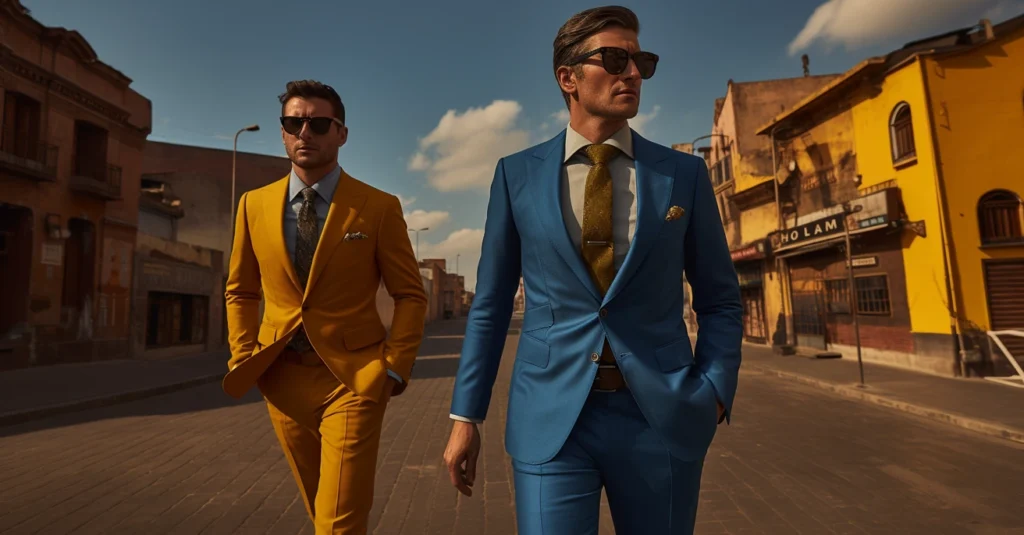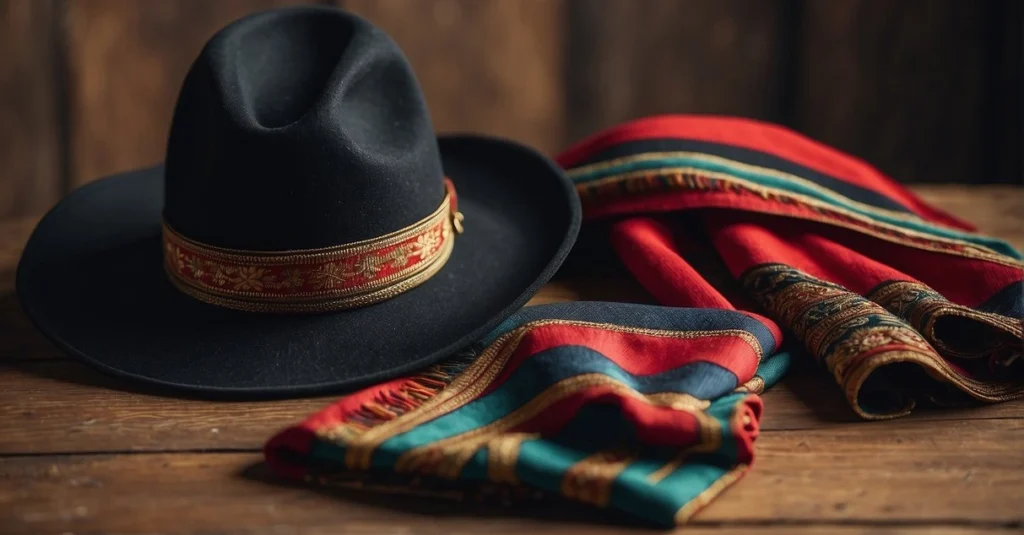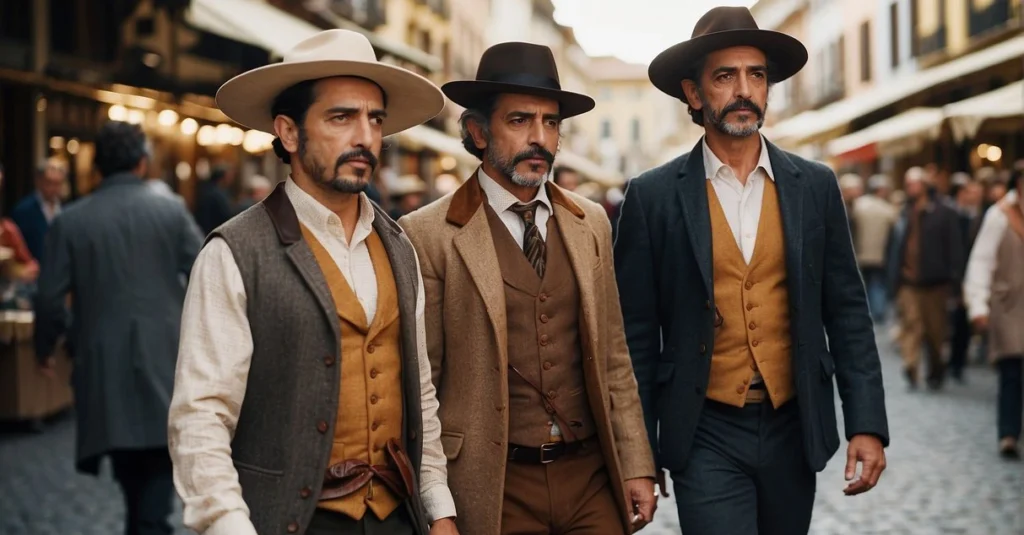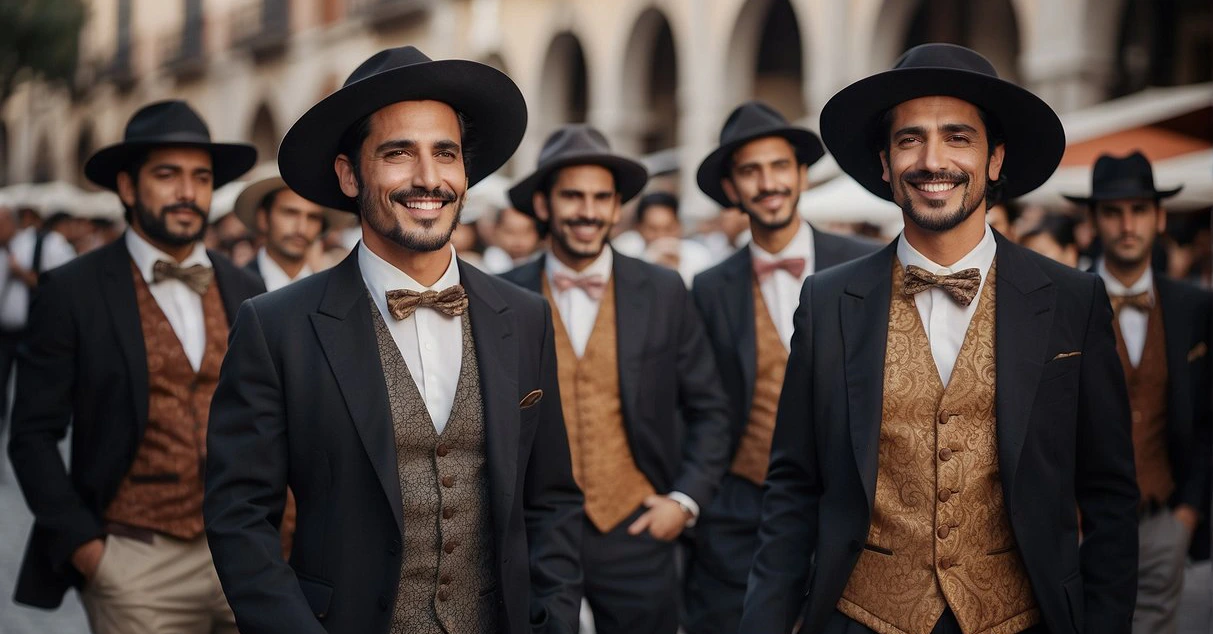When we talk about global fashion, Spanish men’s fashion often doesn’t get as much attention as it truly deserves.
Graced with a rich history and a dynamic contemporary scene, Spain has cultivated a fashion identity that blends traditional elegance with modern innovation.
With brands that range from the high street to bespoke tailoring, Spanish designers have quietly shaped trends and presented an array of styles that are both timeless and forward-thinking.
Table of Contents
ToggleHistorical Evolution of Spanish Men’s Fashion
As we explore Spanish Men’s Fashion, it’s essential to understand how it has transformed from the grandeur of the Renaissance to the varied styles of modernity, reflecting Spain’s rich history and cultural shifts.
From the Renaissance to Modernity

In the Renaissance period, Spanish men’s fashion set the trend with its distinctive silhouettes and attention to precise tailoring.
This era saw the rise of the jubón, a tightly fitted jacket, while voluminous cloaks added a sense of drama.
The 19th century introduced a new notion of masculinity, with men’s fashion in Spain emphasizing fitted garments and subtle ornamentation, as evidenced in professional tailoring journals of the time.
This shift towards a tailored appearance remained a constant throughout the centuries, eventually giving way to modern designers who are masters at merging traditional tailoring with contemporary flair.
Influence of Cultural Movements
Throughout Spanish history, cultural movements played a pivotal role in shaping men’s attire.
The Habsburg and Bourbon dynasties’ influence is notable, favoring elaborate garments that signified wealth and status, which later transitioned into more pragmatic styles due to the Enlightenment’s emphasis on reason and simplicity.
The 20th century’s arts movements, like Cubism and Surrealism, also played their part, contributing to a more experimental and individualized approach to fashion.
Today’s Spanish designers continue to draw on these culturally rich tapestries, consistently infusing traditional styles with innovative elements recognized globally, including a closer look at the appeal of Spanish menswear.
Contemporary Styles in Spanish Men’s Fashion

We’re witnessing a distinct evolution in Spanish Men’s Fashion, marked by vibrant colors, bold patterns, and a blend of traditional tailoring with modern streetwear.
Casual Wear Trends
Casual attire in Spain boasts more than the stereotypical laid-back Mediterranean style; it’s become a canvas for self-expression and cultural identity.
We’re seeing a trend towards eye-popping tones and checks in everything from shirts to trousers.
Brands are championing wide lapels, which can be traced back to Robb Report, highlighting the uniqueness of contemporary Spanish menswear.
Another interesting trend is the infusion of environmentally conscious motifs, such as seen in Barcelona-based TWOTHIRDS.
They produce climate-neutral clothing inspired by the vastness of our oceans, showing that fashion can be both stylish and sustainable.
Suiting Trends and How They Differ from Other European Styles

When it comes to suiting, the Spanish cut is distinct from its European counterparts.
Our designs often feature wider lapels, ties, and collars, establishing a silhouette that’s at once classic and avant-garde.
This blend of the classic influenced by British dressing with a unique Spanish twist sets us apart in the European fashion scene.
The attention to detail and dedication to craftsmanship in our suits create an unparalleled aesthetic that other styles rarely capture.
Unique Accessories in Spanish Men’s Fashion

In Spanish Men’s Fashion, accessories are not just ornaments but a statement of cultural pride and craftsmanship. Let’s explore some iconic pieces that give an outfit that distinctive Spanish flair.
Espadrilles and Spanish Footwear
Espadrilles are synonymous with Spanish style. Originating from the Pyrenees, these comfortable, yet durable, shoes are made from natural materials like cotton canvas and esparto rope for the sole.
Traditionally, these were peasant footwear, but now, they have been elegantly adapted by various brands for a modern twist.
You’ll often find them under big names such as Castañer, which offer a luxurious take on the classic design.
Popular Types of Spanish Footwear:
- Alpargatas: Another term for espadrilles.
- Botas: Rugged leather boots for the countryside.
- Zapatos: The generic term for shoes, often used for dressier styles.
The Role of Hats and Scarves
Beyond shielding from the sun, hats in Spain have a strong traditional significance.
The sombrero cordobés, a wide-brimmed hat from Córdoba, and the boina, a flat wool beret, are widely recognized.
These hats complement both casual and formal attire, serving as a significant aspect of Spanish heritage.
Scarves, too, play a pivotal role in accessorizing; with lightweight materials like silk for summer and heavier, woolen ones for colder months.
They often bear vibrant patterns and colors, nodding to the region’s history and artistry.
Accessories like mantillas, capes, or sashes also reflect Spain’s vibrant cultural heritage as noted in the discussion of Spanish men’s fashion influences.
Style Tips for Embracing Spanish Men’s Fashion

As aficionados of global style, we can’t help but admire the vibrancy and sophistication of Spanish men’s fashion. Whether it’s the streets of Madrid or the bustling lanes of Barcelona, the Spanish approach to menswear often strikes the perfect balance between tradition and modernity. Here’s how we can infuse some of this Iberian flair into our wardrobe.
- Incorporate Color Boldly: Start with a palette that embraces vibrant colors like rich reds and sunny yellows. These hues reflect Spain’s sunny climate and add liveliness to our style.
- Tailoring is Key: Spanish menswear leans towards a more tailored fit. Ensure your clothes are well-fitted, enhancing composure and silhouette, which is integral to a cohesive Spanish look.
- Traditional Meets Contemporary: Mix classic pieces, such as a structured blazer, with modern elements like slim-fit trousers or designer sneakers, creating a connection between the old and the new.
We’ve compiled a straightforward guide to help you adopt Spanish elements confidently:
| Fashion Element | How to Adopt |
|---|---|
| Vibrant Colors | Introduce bold primary colors into outfits |
| Tailored Fit | Invest in custom-fitted clothing |
| Accessories | Opt for leather shoes and minimalistic watches |
To embrace Spanish fashion while respecting its origins, we should be mindful of cultural significance behind certain garments and styles. Engaging with local brands and designers can be a respectful way to appreciate and wear Spanish fashion with authenticity. As enthusiasts looking to expand our style horizons, we find that Spanish menswear, with its roots in cultural heritage and an eye for contemporary trends, offers a unique and exciting aesthetic.
Iconic Spanish Fashion Designers

In discussing the landscape of Spanish men’s fashion, we can’t overlook the influential figures who have shaped its course. These designers have left an indelible mark on the industry, each bringing their unique vision and craftsmanship to the world stage.
Cristóbal Balenciaga
Cristóbal Balenciaga, often hailed as the “master of us all” by his contemporaries, set the standard for haute couture with his exceptional skills and innovative designs. Balenciaga’s influential tailored suits and elaborate evening gowns diverged from the trends of his time, contributing to a timeless style that continues to resonate in fashion circles today.
Paco Rabanne
Another avant-garde designer hailing from Spain is Paco Rabanne. Known for his fearless approach to materials, Rabanne’s use of unconventional elements like metal and plastic challenged traditional notions of men’s and women’s wear. His contributions have been both daring and groundbreaking, solidifying his reputation as a revolutionary within the haute couture scene.
Adolfo Domínguez

Adolfo Domínguez is synonymous with sophisticated simplicity in the realm of Spanish fashion. He introduced the concept of relaxed yet polished fashion with his iconic “wrinkled look,” which became a reference for elegant comfort. Domínguez’s philosophy revolves around natural fabrics and organic lines that emphasize a fluid silhouette.
Enrique Loewe
Lastly, Enrique Loewe stands as a pillar in the legacy of luxury leather goods. Under his steerage, the brand Loewe evolved to embody a blend of classic craftsmanship with modern aesthetics. The house’s commitment to creating pieces with the utmost attention to detail and quality is a testament to Enrique Loewe’s enduring influence on high-end fashion.
Frequently Asked Questions

In our exploration of Spanish men’s fashion, we’ve encountered several recurring inquiries. Here, we address the most common questions to enhance your understanding and appreciation of this distinctive style.
Who are iconic Spanish men’s fashion designers?
Spanish fashion is renowned for its designers who leave an indelible mark on the industry. Designers like Adolfo Domínguez and Roberto Verino offer a mix of timeless sophistication and modern flair, greatly contributing to the unique elements of Spanish fashion.
What are some must-have items in a Spanish-inspired wardrobe?
To infuse your wardrobe with a Spanish touch, consider adding tailored trousers and crisp white shirts for a classic look. A well-fitted blazer paired with stylish loafers can elevate your outfit, capturing the essence of Spanish elegance.
What are the top men’s clothing brands from Spain?
Spain boasts an impressive roster of clothing brands that have gained international acclaim. Brands like Zara and Massimo Dutti lead the market with their contemporary designs and classic wardrobe staples.
Which Spanish men’s fashion brands are available for purchase in the USA?
Many Spanish brands have made their way across the Atlantic. For instance, Mango and Desigual are readily available, bringing Spanish flair to the American fashion scene.
What type of attire is recommended for men when visiting nightclubs in Spain?
Dress codes vary, but a smart-casual look is often preferred in Spanish nightclubs. Opt for a sharp shirt, stylish trousers, and leather shoes to blend in seamlessly with the local nightlife fashion.
If you liked this blog post about the topic: “Spanish Men’s Fashion”, don’t forget to leave us a comment down below to tell us about your experience with it.



